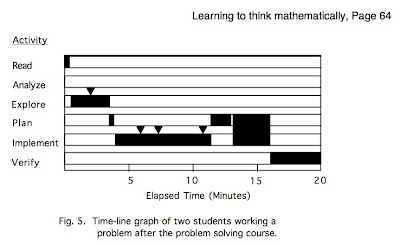Consider how often what we learn reflects what others are doing around us. We watch, we imitate, we adapt what we see to our own styles and interests, we build from there. Now imagine learning to dance when the dancers around you are all invisible. Imagine learning a sport when the players who already know the game can't be seen. Bizarre as this may sound, something close to it happens all the time in one very important area of learning: learning to think.
Thinking is pretty much invisible. To be sure, sometimes people explain the thoughts behind a particular conclusion, but often they do not. Mostly, thinking happens under the hood, within the marvelous engine of our mind-brain.
These paragraphs come from the paper, Making Thinking Visible (PDF), by David Perkins. It provides the backdrop for a session on Metacognitive Memoirs that I am co-facilitating with John Golden for the Michigan Reading Association 2012 Conference. (handout)Not only is others' thinking mostly invisible, so are many circumstances that invite thinking. We would like youngsters, and indeed adults, to become alert and thoughtful when they hear an unlikely rumor, face a tricky problem of planning their time, have a dispute with a friend, or encounter a politician's sweeping statement on television. However, research by our group and others shows that people are often simply oblivious to situations that invite thinking. …
Compare this with an expert who constantly shifts perspectives in order to ensure continual movement toward a solution.
What Schoenfeld determines is that by modeling for students how an expert problem solver thinks, the students can learn to monitor their thinking while solving problems and make the necessary adjustments to be successful.
In the MRA session, we look to children's and young adult literature for examples of characters involved in solving problems. These become models that students can refer back to when it comes time to problem solve. Sometimes the thinking in a book is visible, as in this case from Fish is Fish. (I was introduced to this excellent example by the book, How Students Learn.)
Not all authors make the thinking of their characters visible, however. Therefore, we ask participants to use the comprehension strategy of making inferences to highlight the thinking associated with problem solving. Keene and Zimmermann suggest that effective readers (from Mosaic of Thought, Second Edition - page 260):
- use their schema and textual information to draw conclusions and form unique interpretations from text
- make predictions about text, confirm their predictions, and test their developing meaning as they read on
- know how to use text in combination with their own background knowledge to seek answers to questions; and
- create interpretations to enrich and deepen their experience in a text.
So with a stack of sticky notes and a selection of books, the participants consider how to infer the thinking of various characters - especially during critical problem solving situations. Using reader's chair, participants then share their inferences and what these inferences suggest about the thinking associated with problem solving in the stories.
Hopefully, this flows into the writing of metacognitive math memoirs (which are discussed here and here).



The book's great -- except that I fight the folks deciding that learnign math is like understanding birds and people ... and if you don't get it, well... fish is fish, and you should stay where you belong...
ReplyDelete... I try to get my folks to entertain, when "this looks impossible!" (or "this is different than the other things I know how to do!") to not listen to that voice and to call up one that says "okay, it's different, but I'm supposed to be able to figure this out. What do I know? What do I wish this looked like (because then it would be a problem I could do), and how is it different? Can I do something to it to make it look like one I know how to do?"
(Works really well when the student is told to factor -12x + x^2 + 36, and they just factored 10 perfect square trinomials... but were thrown by the change in order.)